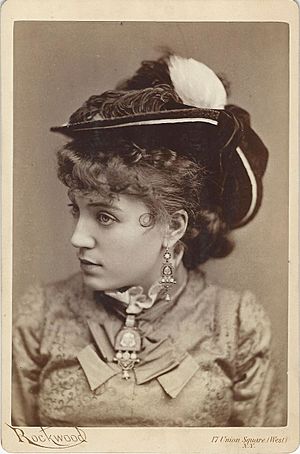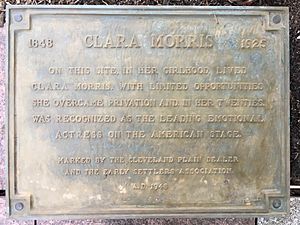Clara Morris facts for kids
Quick facts for kids
Clara Morris
|
|
|---|---|

Clara Morris by George G. Rockwood
|
|
| Born |
Clara Morrison
1846-1849 (disputed) Toronto, Canada West
|
| Died |
New Canaan, Connecticut, United States
|
| Occupation | Actor |
| Spouse(s) |
Frederick C. Harriott
(m. 1874) |
| Signature | |
Clara Morris (born around 184? – died November 20, 1925) was a famous American actress. She was known for playing very emotional characters on stage.
Contents
Early Life
Clara Morris was born in Toronto, which was then called Canada West. She was the oldest child. Sources aren't sure exactly when she was born, but it was likely between 1846 and 1849.
When Clara was three, her father, whose name was La Montagne, was found to have another family. Her mother then moved with Clara to Cleveland, in the United States. They started using Clara's grandmother's last name, Morisson.
Young Clara didn't get much schooling. Around 1860, she became a ballet dancer at the Cleveland Academy of Music. At this time, she shortened her name to Morris. She worked there under the manager John A. Ellsler.
Career
Stage Acting
Clara trained with the Cleveland company for nine years. In 1869, she became a leading actress at Wood's Theatre in Cincinnati. After that, she performed in Halifax, Nova Scotia for a summer. She also worked with actor Joseph Jefferson in Louisville.
In 1870, Clara moved to New York City. She made her big New York debut in September in a play called "Man and Wife." Augustin Daly directed this play at his Fifth Avenue Theatre. Clara got the role by chance, but she impressed everyone. Daly then cast her in many emotional roles over the next three years. Some of these plays included "No Name," "Delmonico's," and "L'Article 47."
Mr. Daly hired her for the Fifth Avenue Theatre. She wasn't meant to be the main star at first. But during rehearsals for "Man and Wife" in 1870, the original lead actress for the role of Anne Silvester quit. Ms. Morris bravely stepped in. On opening night, September 13, she made her debut in a major city. She was so good that the audience called her back for an extra bow early in the play. This was very unusual for theatre at that time!
She left Daly's company in 1873. In November of that year, she starred in "The Wicked World" at the Union Square Theatre. This was under the management of A.M. Palmer.
In 1872, she caused a sensation in the play L'Article 47. More successes followed. Clara became known for her natural and spontaneous acting style.
Over the next few years, Morris had huge hits. These included "Camille" in 1874 and "The New Leah" in 1875. Her most popular role was "Miss Multon" in 1876. This play was an American version of a French play, which was itself based on "East Lynne." She also starred in "Jane Eyre" in 1877 and "The New Magdalen" in 1882.
Clara toured a lot, especially in the 1880s. Everywhere she went, audiences were amazed by her emotional performances. She wasn't considered a great beauty or a perfect artist. She also didn't have formal training in speaking or stage skills. But she had a natural talent for playing strong, often suffering heroines in French plays.
By the 1890s, this type of theatre became less popular. Also, Clara's health was not good. These reasons brought her acting career to an end.
Writing
After retiring from acting, Clara lived in Riverdale, New York. She started writing articles about acting for different magazines. She also wrote a daily newspaper column for ten years. On top of that, she published many books.
Personal Life
Clara Morris married Frederick C. Harriott on November 30, 1874. Clara supported her husband until he started acting with her in 1892.
Later Life and Death
Clara became completely blind in 1910. Her old age was difficult because she faced poverty. The house where she had lived for 37 years was sold in 1914. Morris then moved to Whitestone, Long Island.
She died in New Canaan, Connecticut, on November 20, 1925. She passed away from a heart attack.
Legacy
There is a special plaque on the grounds of the Cleveland Public Library. It marks the spot where Clara Morris lived when she was young. The plaque says: "On this site, in her girlhood, lived Clara Morris. With limited opportunities she overcame privation and, in her twenties, was recognized as the leading emotional actress on the American stage."

Roles

Here are some other important roles she played:
- Lucy Carter in Saratoga
- Mme. D'Artigues in Jezebel
- Tilburnia in The Critic
- Magdalen Vanstone in No Name
- Constance Sherman in Delmonico's, or Larks Up the Hudson
- Miss Lulu Tibbetts in An Angel
Works
After 1885, Clara spent many years focusing on writing. Here are some of her books:
- A Silent Singer (1899)
- Little Jim Crow, and Other Stories of Children (1900)
- Life on the Stage: My Personal Experiences and Recollections (1901)
- A Pasteboard Crown (1902)
- Stage Confidences (1902)
- The Trouble Woman (1904)
- The Life of a Star (1906)
- Left in Charge (1907)
- New East Lynne (1908)
- A Strange Surprise (1910)
- Dressing Room Receptions (1911)
In her book Life on the Stage: My Personal Experiences and Recollections, she wrote about meeting John Wilkes Booth. He was the person who assassinated President Abraham Lincoln.
In Culture
In 2009, Barbara Wallace Grossman published a book called A Spectacle of Suffering: Clara Morris on the American Stage. This book talks about how important Morris was as a "feminist" (someone who supports equal rights for women) in the late 1800s and early 1900s.

